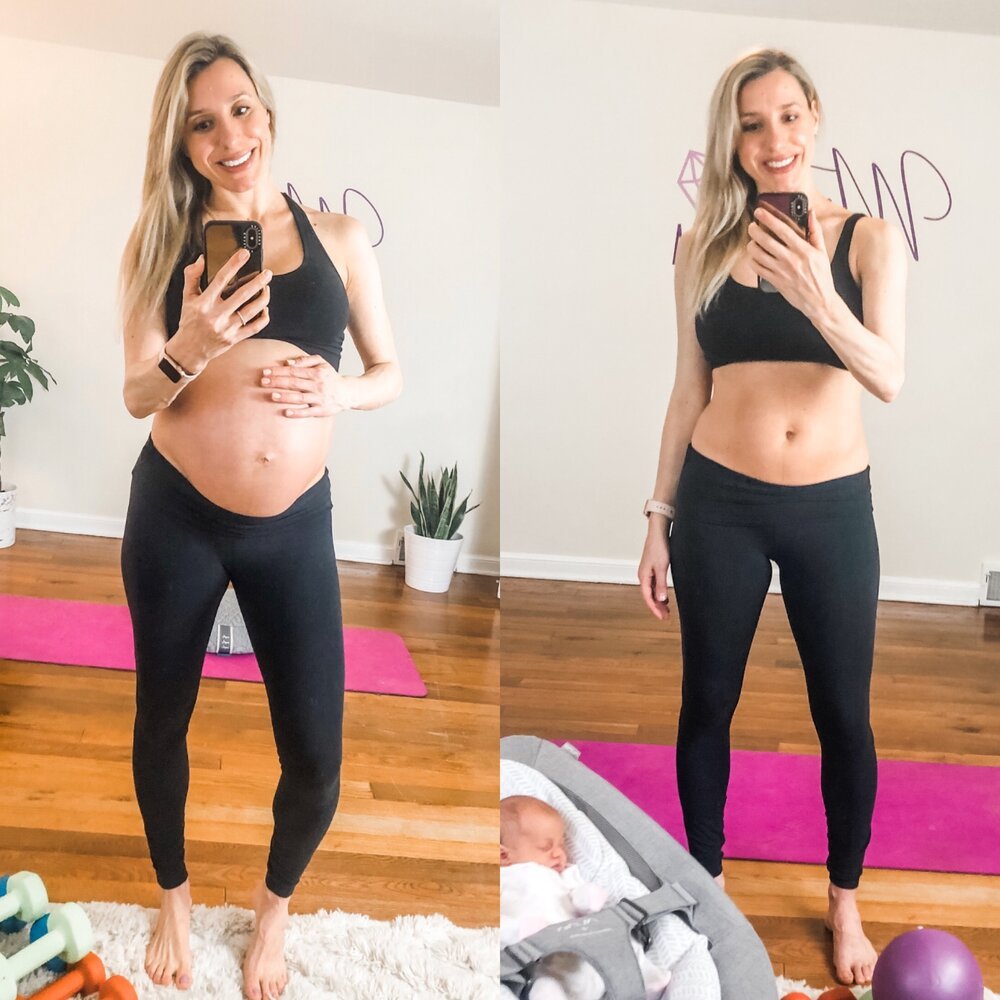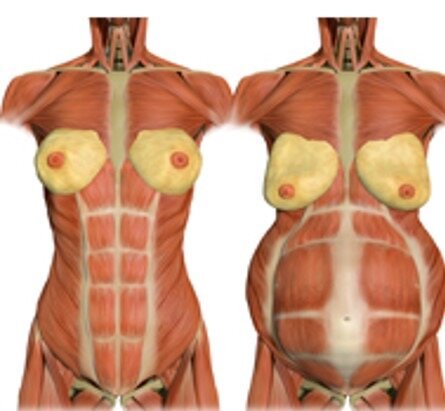Diastasis Recti
You may have heard women talk about “mommy tummy,” “the pooch,” or “mom belly” when referring to a stubborn bulge or doming in the middle of the abdomen post-baby. What these terms actually describe is the effect of diastasis recti abdominis (DRA).
So, what is DRA?
DRA is a separation of the right and left sides of the rectus abdominis muscle (your “6-pack” muscle) due to a thinning and weakening of the connective tissue that runs down the middle of the abdomen and holds the two sides together — called the linea alba. You may have seen or experienced a dark line down the middle of the pregnant belly. This is the linea alba tissue darkened (i.e., linea negra) from changing hormones.
What causes DRA?
Simply put, DRA is caused by excess intra-abdominal pressure (IAP). Taking a look at the figure below, you can see that the linea alba on the left connects and holds together all of the abdominal muscle layers. On the right, the flexible tissue of the linea alba tissue has stretched due to the excessive outward pressure of the growing pregnant belly. Eventually, the tissue thins and stretches so much that its consistency becomes stiff and it loses its ability to hold anything together. When this happens, the outermost muscle layer – rectus abdominis – drifts apart.
What are the symptoms of DRA?
Beyond the annoying “pooch” appearance, abdominal separation may indicate a weak and ineffective core. This can lead to a host of problems including low back pain, pelvic or hip pain, incontinence, constipation, prolapse, or hernia. Do not fear though — DRA and its symptoms can typically be healed without surgery — more on that below!
Who experiences DRA?
Anyone who has excess IAP can experience DRA, but it is most commonly seen in pregnant women. Chances are, if you’ve been pregnant, you have experienced abdominal separation! Does that mean something is wrong? Absolutely not! Please know that some degree of diastasis recti is actually a normal and natural part of pregnancy. It happens in the vast majority of women during their third trimester and is necessary to allow baby room to grow!
Don’t panic if you feel some separation, especially during the third trimester. Your body is doing what it is designed to do. You should not attempt to “close the gap” during pregnancy, but you can avoid certain activities that further exacerbate the excess pressure in your core.
How do you know if you have DRA postpartum?
Most DRA should slowly close and heal by a few months postpartum. Wait at least 6 weeks post-birth to check yourself for DRA or get an assessment from a trained professional. Don’t be tempted (like me!) to check right after giving birth — you will feel a large gap, but that doesn’t mean it will not close!
To self-check for DRA postpartum watch the video or follow the steps below:
Pick a time first thing in the morning or a few hours after eating to avoid bloating (it can compromise results)
Roll onto your side to safely transition to laying on your back with your knees bent and feet planted on the floor
Place one hand behind your head
With the other hand, place two fingers (palm facing you) on your sternum, right below the bra line
First, get a baseline read of your abdomen while at rest; keeping your head on the floor, walk your fingers down the midline of your abdomen until you reach 2 inches below your belly button
Then, check for DRA during exertion; take a deep breath in with your head on the floor then exhale as you lift your head only until your muscles start to fire (typically only 1 inch off the ground)
As you walk your fingers down your midline, check for width of separation (how many fingers you can fit between the ridges of your rectus abdomens muscle) and depth of separation (how shallow and taut or deep and squishy it feels)
Typically the widest and/or deepest gap is at your navel, but not always, so it is important to check the full range (with consistent pressure) from your sternum to 2 inches below your belly button
Feeling a small separation is normal, but a separation greater than 2.7 cm (or about 2 finger-widths) is considered DRA. So, if you can fit two or more fingers between your left and right rectus abdominis, that would be considered DRA.
However, newer research is revealing that depth of separation can actually be a more telling indicator of DRA severity. A gap that feels shallow, taut, and springy, is a good sign because it indicates good integrity of your linea alba. A gap that feels deep and squishy is a sign of more compromised connective tissue, so the healing process may take longer.
When factoring in your width and depth assessments, the depth weighs even more heavily on the speed of your healing process. As an example, a gap that is 3 fingers wide, but quite shallow, will likely take less time to heal than a gap that is 2 fingers wide, but deep.
What can you do to avoid exacerbating DRA during pregnancy and to begin healing it postpartum?
The following tips will help you better manage the pressure within your core as your belly grows, and therefore help you to heal faster in the postpartum period. If you have DRA already, these are also excellent tips to begin your healing.
Neutral Alignment: Neutral alignment is key to reducing stress on your muscles and soft tissues. Neutral means a vertical stacking of ear-shoulder-hips-knees-ankles, as well as a neutral pelvis position (stacked in parallel under the rib cage). Unfortunately, pregnancy tends to pull your body out of neutral. For example, it is common to experience excessive lower back arch from the growing belly tipping the pelvis forward. This not only increases pressure on your lower back, but also your abdominal wall, and pelvic floor.
360 Breathing: This is so important whether you are pregnant/postpartum or not! Proper breathing (i.e., deep core or diaphragmatic breathing) activates the deep core muscles of your core canister which helps to regulate intra-abdominal pressure. Learn how to do 360 Breathing here.
Avoid Improper Core Work: During pregnancy, you should avoid spinal flexion (crunching), extension (back-bends or arches), lateral flexion (side bends), and rotation with disassociation of hips and shoulders (twisting) as your belly grows. All these movements create too much IAP when performed with a belly. In addition, planks and plank-like moves will need to be regressed, and eventually avoided. Both during pregnancy and postpartum, stop if you notice coning or a torpedo like shape of your abdomen during any movement. That is likely DRA and continuing will worsen the separation.
By reading this blog, you agree not to use the content as medical advice to treat any medical condition in either yourself or others. Please consult your physician before starting any new exercise program or technique, whether pregnant or not. Under no circumstances shall Motion Melissa LLC, any guests or contributors to the blog, or any employees, associates, or affiliates of Motion Melissa LLC be responsible for damages arising from use of this content. Thank you for being here!


